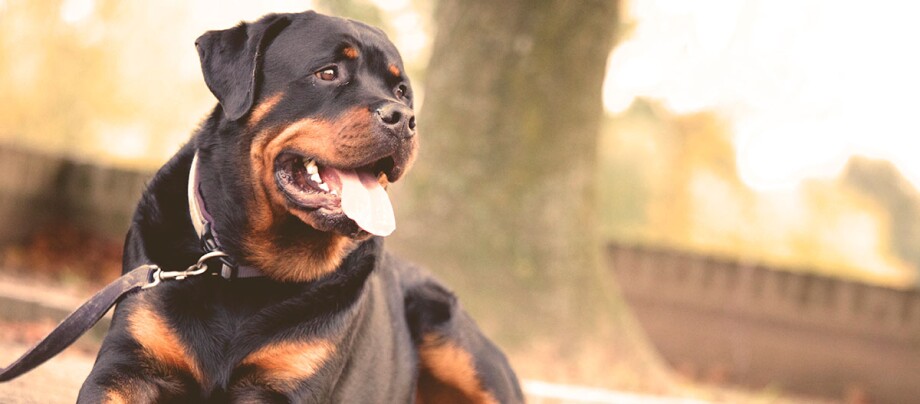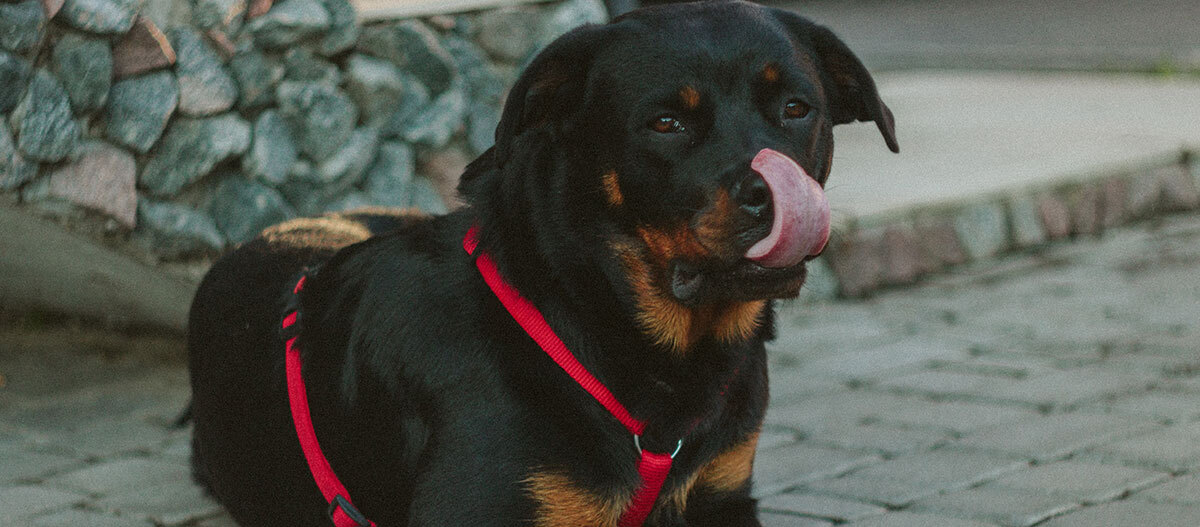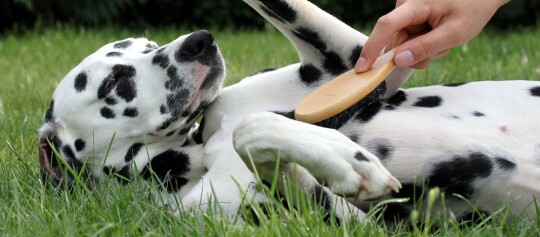Rottweiler – four-legged law enforcement officer and brave bodyguard
18.02.2024 - Reading time: 9 minutes

The police and security services would have a hard time without its help: The impressive Rottweiler’s qualities as a guard and protection dog make it indispensable wherever something is in need of guarding or defending. The Rottweiler is not your typical, easy-going companion dog. However, if you appreciate having a four-legged guardian, the Rottweiler is ideal – provided you have the necessary experience with dogs and the time to keep him busy.
- Roman cattle, Germanic merchants: the history of the Rottweiler
- Rottweiler breed classification
- Rottweiler profile
- Is the Rottweiler listed as a dangerous breed?
- Appearance, size and weight of the Rottweiler
- Temperament of the Rottweiler: Is a Rottweiler aggressive?
- Buying a Rottweiler – what to consider
- Training and looking after a Rottweiler: Is a Rottweiler suitable for first-time owners?
- Does the Rottweiler make a good family dog?
- How much does a Rottweiler puppy cost?
- Taking care of a Rottweiler
Roman cattle, Germanic merchants: the history of the Rottweiler
The Rottweiler is one of Germany’s oldest breeds of dog. However, its roots lie beyond the Alps and its origins extend back as far as Roman times. At that time, the Romans brought animals as well as cultural achievements to the territories they conquered. They used the Rottweiler’s ancestors to guard herds of cattle, which served as live provisions for the legions. Local cattle traders were very impressed by these strong dogs, because they too had to safely move their animals along the trade routes. This is how the original Rottweiler came to Germany. Around the town of Rottweil, the Roman animals mixed with the native dogs, resulting in the emergence of the Rottweiler. The town’s butchers also appreciated the Rottweiler’s qualities as a guard dog for the cattle, and it was at this time that the name ‘Rottweiler butcher’s dog’ became widely used.
The Rottweiler has been an officially recognised breed since 1910. Industrialisation resulted in it no longer being used as a herding dog in many places. At the beginning of the 20th century, efforts were being made to identify breeds that could work with the police force. The Rottweiler was also tested for its suitability and it was soon established that Rottweilers were ideally suited to working for the police. Nowadays, the Rottweiler is mainly used by the police and military. Their steady nerves and even-tempered, calm nature help them to perform their duties. Thanks to its resilient, willing and obedient nature, the Rottweiler is also used as an assistance dog in disaster zones. Its alert, calm and self-confident nature means that it also makes a great tracking, guide and therapy dog. A Rottweiler is not easily flustered; it acts quickly, deliberately and purposefully, there is no trace of nervousness.
Rottweiler breed classification
The appearance and nature of dog breeds are precisely defined. The FCI – Fédération Cynologique Internationale – is a federation comprised of several countries’ kennel clubs that has existed since 1911. According to the FCI, there are 367 defined dog breeds, which are then divided into groups. The Rottweiler belongs to FCI group 2, section 2: the Molossian types. These also include the Hovawart, German Boxer and Leonberger. Animals belonging to this group are strong in build and were bred to look threatening, as they were used as guard dogs, among other things. Rottweilers and other representatives of this group were used to guard livestock and hunt big game, among other things, and prior to this they are even said to have been used in gladiator fights.
NewsletterRottweiler
Breed | Rottweiler |
Origin | Germany |
Classification | Molossian type, mastiff type |
Size | male 61 to 68 centimetres at shoulder height – female 56 to 63 centimetres at shoulder height |
Weight | male 50 kilograms – female 42 kilograms |
Physique | strong, compact, not plump, tail sits horizontal to body |
Eyes | dark, medium in size, almond-shaped |
Ears | medium in size, close against head |
Coat and colour | close, short double coat; colour: black with reddish-brown markings on face, chest, legs and base of tail (‘black and tan’) |
Special characteristics | females shed before coming into heat |
Nature | confident and brave, obedient, docile and friendly |
Care | brush regularly |
Health | genetic predisposition to hip and elbow dysplasia, heart problems, paralysis |
We have the best products for your English bulldog!
Is the Rottweiler listed as a dangerous breed?
Although the Rottweiler was never specifically bred to fight, and is in fact an old working dog, it is now listed as a dangerous dog in some German states. Dogs placed on this list are regarded as potentially dangerous. This means that owners need to meet special requirements to be permitted to keep a Rottweiler. Such requirements may include, for example, a clearance certificate or a certificate of competence. In some cases, the dog can be kept without issue if it is able to pass a temperament test. In some places, however, no exemptions from the requirement to always keep the dog leashed and muzzled are granted. Please familiarise yourself with any local legal regulations before getting a dog.
Appearance, size and weight of the Rottweiler
Rottweilers are medium to large in size and, depending on their sex, reach a shoulder height of 61 to 68 centimetres (males) or 56 to 63 centimetres (females). Fully grown, males weigh around 50 kilograms, while females weigh around 42 kilograms. The Rottweiler’s head is medium in length and typically broad between the ears. Its wide, powerful jaws and strong teeth are particularly striking. The Rottweiler is also known for its typical build and coat colour. Their short, dense coat ranges from black to dark brown, with some rusty brown markings on the face, legs and chest as well as around the base of the tail. The Rottweiler also grows a dense undercoat in winter. Other characteristics of this breed include its medium-sized, floppy ears that lie close to its head, its almond-shaped, dark brown eyes and its generally sturdy stature. There is not a great deal of colour variation in the Rottweiler. Despite its muscular build, it does not look plump, but rather athletic. Its movements are fluid and powerful.
Temperament of the Rottweiler: Is a Rottweiler aggressive?
Rottweilers are considered to be confident, daring and vigilant. However, they are also very affectionate, need a lot of social contact and their general demeanour is friendly and peaceful. In regard to its surroundings, the Rottweiler is alert, yet calm. The Rottweiler has not completely shaken off the herding instinct of its ancestors. A willingness to defend and courage are key characteristics of this breed. However, these can turn into dominant behaviours. It is up to you to make it clear to your Rottweiler, with patience and consistency, that you and your family come first in the hierarchy. Otherwise, the animal’s behaviour can get out of hand, as the Rottweiler will quickly take the lead itself. Without sufficient training and activities to keep it occupied, and without a strong enough bond with its owner, the sensitive Rottweiler might begin to show signs of unwanted behaviours or aggression. As the owner of a Rottweiler, you should therefore project an air of confidence.

Buying a Rottweiler – what to consider
It is important to have an understanding of the Rottweiler’s potential temperament and training requirements before getting one, regardless of whether you are looking to buy an adult Rottweiler or a Rottweiler puppy. The same applies if you are interested in getting a Rottweiler crossbreed, or Rottweiler mix, as they are also known. Even in a Rottweiler-GSD mix or a Labrador-Rottweiler mix, the Rottweiler’s character traits can present themselves to varying degrees. Think about whether you have the time and consistency needed to really get the best out of your dog.
Training and looking after a Rottweiler: Is a Rottweiler suitable for first-time owners?
Training a Rottweiler is a job best left to an experienced and assertive owner. The Rottweiler is not recommended for first-time dog owners. Alternatively, first-time owners should adopt an older, calm Rottweiler from an animal shelter: as is the case with every breed, each Rottweiler has its own unique personality.
In any case, bear in mind that a Rottweiler needs tasks and activities that it can complete as part of a job. The Rottweiler is very territorial by nature and it will reliably guard its patch. After all, it is for good reason that the Rottweiler is valued as a guard dog and working dog for the police and security services, or in other words, in any situation in which it is desirable for the dog itself to possess a certain air of authority. The Rottweiler is also still used as a herding dog. As it is mandatory for your Rottweiler to wear a muzzle in some places, at least on public transport, you should get it used to wearing one. It is advisable to familiarise your Rottweiler with wearing a muzzle from when it is a puppy.
Does the Rottweiler make a good family dog?
The life of a happy and well-rounded dog includes not only care, good grooming, a healthy diet etc., but also sufficient activities and exercise. Without exercise and intensive training, a Rottweiler often does not make a classic family dog or a dog that can join in leisure activities with you. In addition, their sheer size and strength mean that a person might not necessarily be able to handle them if the animal gets it into its head that it can just do its own thing. However, as a sports companion of an active owner and with sufficient intellectual stimulation, such as that offered by tracking training, for instance, a Rottweiler whose needs as a breed are being met makes an excellent companion that forms a close bond with its owner. Furthermore, due to its friendly and peaceful nature, it can also be suitable for families with children. However, it is advisable to always supervise children with the dog. In addition to consistent training, a Rottweiler should be given plenty of attention and petting, as it thrives on being close to people and sharing a bond with them. Agility, obedience training or dog dance are possible activities you could do with a Rottweiler.
How much does a Rottweiler puppy cost?
It is not easy to give an average price for a Rottweiler. How much an adult Rottweiler or a puppy costs can depend, for example, on whether you get it from an animal welfare organisation or buy it from a breeder. You should always make sure that you only get your four-legged friend from a reputable Rottweiler breeder or another reputable source.
Taking care of a Rottweiler
Rottweilers tend to be overweight. This is why it is important to correctly ration your four-legged friend’s food and not give in to begging. You should regularly clean the dogs floppy ears to prevent irritation. Its short coat is generally easy to care for, but regular brushing will prevent excessive hair loss. Brushing also stimulates the circulation. Regular brushing is especially important when your Rottweiler is shedding in spring and autumn, as it helps remove loose hair from its coat. Your dog will shed for around six to eight weeks. Grooming gloves or other dog grooming brushes are suitable for looking after your dog’s coat.
As with many large dogs, the Rottweiler’s life expectancy, which is around ten years on average, is lower than that of smaller breeds. Due to their size, Rottweilers as a breed are prone to dysplasia and heart problems.

